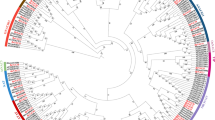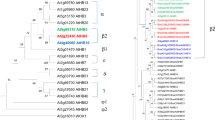Abstract
Reversible acetylation of core histones plays an important role in the epigenetic regulation of gene transcription, and is controlled by the action of histone acetyltransferases (HATs) and histone deacetylases (HDACs). While HDACs have been well studied in Drosophila melanogaster, information from insect pests is still limited. In the current study, we cloned and characterized three class I enzymes, TcHDAC1, TcHDAC 3 and TcHDAC 8, in the red flour beetle, Tribolium castaneum. Expression profiling showed that T. castaneum HDAC genes are expressed in all developmental stages and tissues examined. A dramatic increase of mRNA expression level was observed from prepupae to 1-day-old pupae for all three T. castaneum HDAC genes. Both TcHDAC1 and TcHDAC3 exhibited the highest mRNA expression levels in thorax, whereas TcHDAC8 was highly expressed in fat body. Furthermore, T. castaneum HDAC genes were found to respond to heat, cold and oxidative stresses. While the heat-stress treatment decreased the mRNA expression levels of T. castaneum HDAC genes, their transcripts were induced by paraquat treatment. These results suggest a possible role for class I HDAC genes in the epigenetic regulation of T. castaneum development and stress responses.








Similar content being viewed by others
References
Achary BG, Campbell KM, Co IS, Gilmour DS (2014) RNAi screen in Drosophila larvae identifies histone deacetylase 3 as a positive regulator of the hsp70 heat shock gene expression during heat shock. Biochim Biophys Acta 1839:355–363
Arakane Y, Li B, Muthukrishnan S, Beeman RW, Kramer KJ, Park Y (2008) Functional analysis of four neuropeptides, EH, ETH, CCAP and bursicon, and their receptors in adult ecdysis behavior of the red flour beetle, Tribolium castaneum. Mech Dev 125:984–995
Carré C, Szymczak D, Pidoux J, Antoniewski C (2005) The histone H3 acetylase dGcn5 is a key player in Drosophila melanogaster metamorphosis. Mol Cell Biol 25:8228–8238
Chen T, Sun H, Lu J, Zhao Y, Tao D, Li X, Huang B (2002) Histone acetylation is involved in hsp70 gene transcription regulation in Drosophila melanogaster. Arch Biochem Biophys 408:171–176
Cho Y, Griswold A, Campbell C, Min KT (2005) Individual histone deacetylases in Drosophila modulate transcription of distinct genes. Genomics 86:606–617
Fogg PC, O’Neill JS, Dobrzycki T, Calvert S, Lord EC, McIntosh RL, Elliott CJ, Sweeney ST, Hastings MH, Chawla S (2014) Class IIa histone deacetylases are conserved regulators of circadian function. J Biol Chem 289:34341–34348
Gregoretti IV, Lee YM, Goodson HV (2004) Molecular evolution of the histone deacetylase family: functional implications of phylogenetic analysis. J Mol Biol 338:17–31
Haberland M, Montgomery RL, Olson EN (2009) The many roles of histone deacetylases in development and physiology: implications for disease and therapy. Nat Rev Genet 10:32–42
Haliscak JP, Beeman RW (1983) Status of malathion resistance in five genera of beetles infesting farm-stored corn, wheat and oats in the United States. J Econ Entomol 76:717–722
Hogenkamp DG, Arakane Y, Kramer KJ, Muthukrishnan S, Beeman RW (2008) Characterization and expression of the b-N-acetylhexosaminidase gene family of Tribolium castaneum. Insect Biochem Mol Biol 38:478–489
Johnson CA, Barlow AL, Turner BM (1998) Molecular cloning of Drosophila melanogaster cDNAs that encode a novel histone deacetylase dHDAC3. Gene 221:127–134
Kouzarides T (2007) Chromatin modifications and their function. Cell 128:693–705
Lu K, Shu Y, Zhou J, Zhang X, Zhang X, Chen M, Yao Q, Zhou Q, Zhang W (2015) Molecular characterization and RNA interference analysis of vitellogenin receptor from Nilaparvata lugens (Stål). J Insect Physiol 73:20–29
Ma X, Zhang B, Liu C, Tong B, Guan T, Xia D (2017) Expression of a populus histone deacetylase gene 84KHDA903 in tobacco enhances drought tolerance. Plant Sci 265:1–11
Mannervik M, Levine M (1999) The Rpd3 histone deacetylase is required for segmentation of the Drosophila embryo. Proc Natl Acad Sci USA 96:6797–6801
Moser MA, Hagelkruys A, Seiser C (2014) Transcription and beyond: the role of mammalian class I lysine deacetylases. Chromosoma 123:67–78
Mukherjee K, Fischer R, Vilcinskas A (2012) Histone acetylation mediates epigenetic regulation of transcriptional reprogramming in insects during metamorphosis, wounding and infection. Front Zool 9:25–25
Niu Y, DesMarais TL, Tong Z, Yao Y, Costa M (2015) Oxidative stress alters global histone modification and DNA methylation. Free Radic Biol Med 82:22–28
Oger F, Dubois F, Caby S, Noël C, Cornette J, Bertin B, Capron M, Pierce RJ (2008) The class I histone deacetylases of the platyhelminth parasite Schistosoma mansoni. Biochem Biophys Res Commun 377:1079–1084
Reynolds JA, Bautista-Jimenez R, Denlinger DL (2016) Changes in histone acetylation as potential mediators of pupal diapause in the flesh fly, Sarcophaga bullata. Insect Biochem Mol Biol 76:29–37
Rogina B, Helfand SL, Frankel S (2002) Longevity regulation by Drosophila Rpd3 deacetylase and caloric restriction. Science 298:1745–1745
Rubertis FD, Kadosh D, Henchoz S, Pauli D, Reuter G, Struhl K, Spierer P (1996) The histone deacetylase RPD3 counteracts genomic silencing in Drosophila and yeast. Nature 384:589–591
Sako K, Kim JM, Matsui A, Nakamura K, Tanaka M, Kobayashi M, Saito K, Nishino N, Kusano M, Taji T, Yoshida M, Seki M (2016) Ky-2, a histone deacetylase inhibitor, enhances high-salinity stress tolerance in Arabidopsis thaliana. Plant Cell Physiol 57:776–783
Seto E, Yoshida M (2014) Erasers of histone acetylation: the histone deacetylase enzymes. Cold Spring Harb Perspect Biol 6:a018713
Tabunoki H, Gorman MJ, Dittmer NT, Kanost MR (2016) Superoxide dismutase 2 knockdown leads to defects in locomotor activity, sensitivity to paraquat, and increased cuticle pigmentation in Tribolium castaneum. Sci Rep 6:29583. https://doi.org/10.1038/srep29583
Tamura K, Peterson D, Peterson N, Stecher G, Nei M, Kumar S (2011) MEGA5: molecular evolutionary genetics analysis using maximum likelihood, evolutionary distance, and maximum parsimony methods. Mol Biol Evol 28:2731–2739
Thompson JD, Higgins DG, Gibson TJ (1994) CLUSTAL W: improving the sensitivity of progressive multiple sequence alignment through sequence weighting, position-specific gap penalties and weight matrix choice. Nucleic Acids Res 22:4673–4680
To TK, Nakaminami K, Kim JM, Morosawa T, Ishida J, Tanaka M, Yokoyama S, Shinozaki K, Seki M (2011) Arabidopsis HDA6 is required for freezing tolerance. Biochem Biophys Res Commun 406:414–419
Turner BM (2007) Defining an epigenetic code. Nat Cell Biol 9:2–6
Verdin E, Ott M (2015) 50 years of protein acetylation: from gene regulation to epigenetics, metabolism and beyond. Nat Rev Mol Cell Biol 16:258–264
Vidal M, Gaber RF (1991) RPD3 encodes a second factor required to achieve maximum positive and negative transcriptional states in Saccharomyces cerevisiae. Mol Cell Biol 11:6317–6327
Wang Z, Zang C, Cui K, Schones DE, Barski A, Peng W, Zhao K (2009) Genome-wide mapping of HATs and HDACs reveals distinct functions in active and inactive genes. Cell 138:1019–1031
Woods JK, Ziafazeli T, Rogina B (2016) Rpd3 interacts with insulin signaling in Drosophila longevity extension. Aging 8:3028–3044
Zhu CC, Bornemann DJ, Zhitomirsky D, Miller EL, O’Connor MB, Simon JA (2008) Drosophila histone deacetylase-3 controls imaginal disc size through suppression of apoptosis. PLoS Genet 4:e1000009
Zhu F, Parthasarathy R, Bai H, Woithe K, Kaussmann M, Nauen R, Harrison DA, Palli SR (2010) A brain-specific cytochrome P450 responsible for the majority of deltamethrin resistance in the QTC279 strain of Tribolium castaneum. Proc Natl Acad Sci USA 107:8557–8562
Acknowledgements
This work was supported by the National Natural Science Foundation of China under Grant Nos. 31572000 and 31871974.
Author information
Authors and Affiliations
Corresponding author
Ethics declarations
Conflict of interest
All authors declare that there are no conflicts of interest.
Additional information
Publisher's Note
Springer Nature remains neutral with regard to jurisdictional claims in published maps and institutional affiliations.
Rights and permissions
About this article
Cite this article
Chen, M., Zhang, N., Jiang, H. et al. Molecular characterization of class I histone deacetylases and their expression in response to thermal and oxidative stresses in the red flour beetle, Tribolium castaneum. Genetica 147, 281–290 (2019). https://doi.org/10.1007/s10709-019-00065-3
Received:
Accepted:
Published:
Issue Date:
DOI: https://doi.org/10.1007/s10709-019-00065-3




